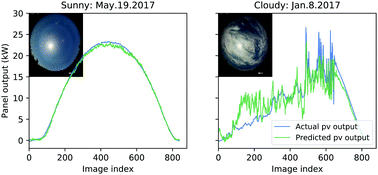当前位置:
X-MOL 学术
›
Energy Environ. Sci.
›
论文详情
Our official English website, www.x-mol.net, welcomes your feedback! (Note: you will need to create a separate account there.)
Solar PV output prediction from video streams using convolutional neural networks
Energy & Environmental Science ( IF 32.5 ) Pub Date : 2018-04-20 00:00:00 , DOI: 10.1039/c7ee03420b Yuchi Sun 1, 2, 3 , Gergely Szűcs 2, 3, 4 , Adam R. Brandt 1, 2, 3
Energy & Environmental Science ( IF 32.5 ) Pub Date : 2018-04-20 00:00:00 , DOI: 10.1039/c7ee03420b Yuchi Sun 1, 2, 3 , Gergely Szűcs 2, 3, 4 , Adam R. Brandt 1, 2, 3
Affiliation

|
Solar photovoltaic (PV) installation is growing rapidly across the world, but the variability of solar power hinders its further penetration into the power grid. Part of the short-term variability stems from sudden changes in meteorological conditions, i.e., change in cloud coverage, which can vary PV output significantly over timescales of minutes. Images of the sky provide information on current and future cloud coverage, and are potentially useful in inferring PV generation. This work uses convolutional neural networks (CNN) to correlate PV output to contemporaneous images of the sky (a “now-cast”). The CNN achieves test-set relative-root-mean-square error values (rRMSE) of 26.0% to 30.2% when applied to power outputs from two solar PV systems. We explore the sensitivity of model accuracy to a variety of CNN structures, with different widths, depths, and input image resolutions among other hyper-parameters. This success at “now-cast” prediction points to possible future uses for short-term forecasts.
中文翻译:

使用卷积神经网络从视频流预测太阳能光伏输出
太阳能光伏(PV)装置在世界范围内发展迅速,但是太阳能的多变性阻碍了其进一步渗透到电网中。短期变化的部分原因是气象条件的突然变化,即云覆盖率的变化,这可能会在几分钟的时间范围内显着改变PV输出。天空图像可提供有关当前和将来的云覆盖范围的信息,并且在推断光伏发电量方面可能很有用。这项工作使用卷积神经网络(CNN)将PV输出与同时期的天空图像(“现浇”)相关联。当将CNN应用于两个太阳能光伏系统的功率输出时,其测试设置的相对均方根误差值(rRMSE)为26.0%至30.2%。我们探索了模型精度对各种CNN结构的敏感性,这些结构具有不同的宽度,深度和其他超参数之间的输入图像分辨率。“即时预测”预测的成功表明了短期预测的未来可能用途。
更新日期:2018-04-20
中文翻译:

使用卷积神经网络从视频流预测太阳能光伏输出
太阳能光伏(PV)装置在世界范围内发展迅速,但是太阳能的多变性阻碍了其进一步渗透到电网中。短期变化的部分原因是气象条件的突然变化,即云覆盖率的变化,这可能会在几分钟的时间范围内显着改变PV输出。天空图像可提供有关当前和将来的云覆盖范围的信息,并且在推断光伏发电量方面可能很有用。这项工作使用卷积神经网络(CNN)将PV输出与同时期的天空图像(“现浇”)相关联。当将CNN应用于两个太阳能光伏系统的功率输出时,其测试设置的相对均方根误差值(rRMSE)为26.0%至30.2%。我们探索了模型精度对各种CNN结构的敏感性,这些结构具有不同的宽度,深度和其他超参数之间的输入图像分辨率。“即时预测”预测的成功表明了短期预测的未来可能用途。



























 京公网安备 11010802027423号
京公网安备 11010802027423号